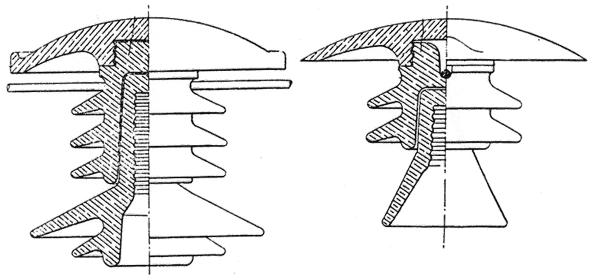[Trade Journal]
Publication: Electrical World
New York, NY, United States
vol. 53, no. 3, p. 148-149, col. 2, 1
Umbrella-Type Insulators.
The chief point to be kept in view in designing insulators for very high voltages is to avoid superficial disruptive discharges, especially when the insulators are exposed to heavy rains. The outer petticoat, on the top of which the conductor is secured, extends outwardly to a considerable extent to protect the smaller and lower petticoats from water. When the upper petticoat has got wet, its potential is the same as that of the conductor, wherefore its upper surface is quite inefficient from the point of view of insulation. Moreover, the water drops, falling down from the upper petticoat, when succeeding each other at short intervals, offer an easy path to the disruptive discharges between the edge of the petticoat itself and the supporting pin or the cross-arm. For the above reason high-tension insulators usually are very large and very difficult to manufacture.
 |
| Figs. 1 and 2. — Umbrella-Type Insulators. |
According to a United States patent issued on Dec. 8 to Mr. Guido Semenza, of Milan, Italy, the different tasks are accomplished by different parts of the insulator and the troubles depending upon the rain are obviated so as to afford an insulator the efficacy of which against external disruptive discharges is claimed to be almost as high in wet as in dry weather. This result is attained by making the insulator of two distinct parts: the lower one, which is the insulator proper, is intended to support the conductor and does not require any outwardly extending upper petticoat; the upper part, which is termed the cap, is secured above the insulator proper and may be formed of any insulating material whatever as it is intended only to protect the lower petticoats of the insulator proper from rain, rendering the water drops dripping from said upper cap innocuous.
Figs. 1 and 2 show two arrangements. According to Fig. 1 the spigot-shaped top of the insulator proper is fitted with screw threads for securing the cap thereto; a lower circular recess is intended to receive the conductor, if it is to be tied to the insulator laterally. According to Fig. 2 the top is fitted with a central recess wherein the conductor rests, in the case of central tying being resorted to.
The following advantageous features are claimed for the above arrangements:
(1) The cap has no insulating function, so as to allow of its being composed of a material of low dielectric rigidity, while its size, even if very large, does not give rise to special difficulties of manufacture as is the case with the large petticoat insulators now in use.
(2) The water dripping from the cap does not come into contact with the conductor and does not, therefore, render the superficial disruptive discharges easier.
(3) The gutters prevent the water from the cap dripping on the conductor. The latter, therefore, receives only the direct rain, which, owing to the conductor having a certain sag, follows the same up to a certain extent before leaving it.
(4) The petticoats situated below the cap are completely protected thereby and will therefore remain dry.
It is said that the insulator proper may henceforth be made much smaller and its manufacture will prove much easier and cheaper than is the case with the present types.
